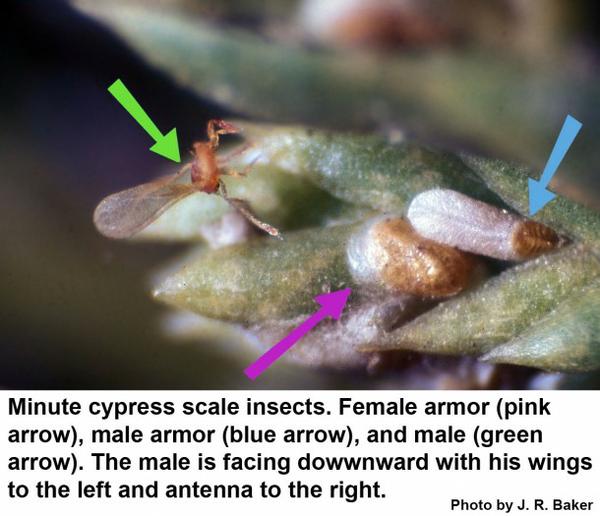Description and Biology
The minute cypress scale insect, Carulaspis minima, is a very small (up to 1 mm wide) armored scale insect. The armor of females is circular to oval and is white and parchment-like. In the center is a light yellow cast skin of an earlier nymph stage. The armor of the male scales is oblong, white and about 1 mm long. At one end is the pale yellow cast skin of the crawler stage. Adult males are tiny, gnat-like insects with four eyes and a tiny waxy tail filament. Little is known of the biology of minute cypress scale insects. If they behave like other armored scales, these scales hatch from eggs laid by the mother scale under her armor. The tiny crawlers emerge to crawl about seeking a suitable place to feed. Female scales molt twice before maturing and male scales molt three times. Males emerge from the male armor and seek females with which to mate. The males soon die. Females soon lay eggs for another generation. After laying eggs, the females die. The armor of both males and females clings to the infested shrubs long after the scales inside die (females) or leave (males).
Host Plants
Minute cypress scales are found on the needles and bark of junipers, cypresses, and Leyland cypress. Because they are so small, minute cypress scales are easily overlooked. The minute cypress scale seems to be a debilitating pest of junipers and Leyland cypress and is considered an economic pest. Infested plants dieback and are off color.
Residential Recommendation
Pesticide sprays are often required for control. Horticultural oils or Safari should give adequate control of the minute cypress scale if used twice about 14 days apart.
References
- Armored Scale Identification and Management on Ornamental Plants. Frank, S. 2010. Entomology Insect Notes, NC State Extension Publications.
- Horticultural Oils for Ornamental Plants. Frank, S. et al. 2023 (revised). Entomology Insect Notes, NC State Extension Publications.
- Landscape - Scale Insects: Minute Cypress Scale. Johnson, G. 2009. U. Delaware Coop. Ext., Kent Co., Commercial Hort. Information.
- Extension Plant Pathology Publications and Factsheets
- Horticultural Science Publications
- North Carolina Agricultural Chemicals Manual
For assistance with a specific problem, contact your local N.C. Cooperative Extension Center.
This Factsheet has not been peer reviewed.
Publication date: May 14, 2013
Reviewed/Revised: Oct. 4, 2019
Recommendations for the use of agricultural chemicals are included in this publication as a convenience to the reader. The use of brand names and any mention or listing of commercial products or services in this publication does not imply endorsement by NC State University or N.C. A&T State University nor discrimination against similar products or services not mentioned. Individuals who use agricultural chemicals are responsible for ensuring that the intended use complies with current regulations and conforms to the product label. Be sure to obtain current information about usage regulations and examine a current product label before applying any chemical. For assistance, contact your local N.C. Cooperative Extension county center.
N.C. Cooperative Extension prohibits discrimination and harassment regardless of age, color, disability, family and marital status, gender identity, national origin, political beliefs, race, religion, sex (including pregnancy), sexual orientation and veteran status.



